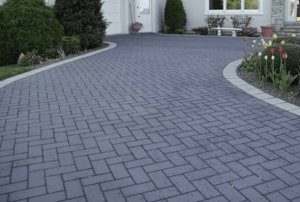Driveways can be prone to cracking and potholes. If the damage is isolated and does not exceed a quarter inch in width, patching is an option.
However, if the damage is widespread and beyond repair, it may be time to replace your driveway. A professional concrete contractor can assess the situation and recommend the best course of action. Contact Driveway Repair Charleston now!

Cracks in driveways are common, but if not addressed, they can get worse. Cracks can allow water and debris to seep under the surface, further damaging the concrete. Cracks can also develop into a tripping hazard or provide an entry point for insects and vegetation. The best way to avoid damage is to keep up with maintenance, including cleaning, weeding and watering. Small, hairline cracks can be filled with a concrete crack filler or liquid sealant for an easy DIY repair. Be sure to follow the manufacturer’s instructions for proper application. Once the filler has cured, apply a concrete sealer to prevent moisture infiltration and extend the life of your repair.
When cracks become wider, they are more difficult to repair, and can indicate an underlying problem that requires professional assessment and assistance. Wide fissures can lead to sinking sunken slabs, structural problems and other issues that will require extensive restoration work.
Before you start any crack repair, thoroughly clean the damaged area to remove dirt, debris and broken pieces of concrete. Use a power washer, stiff broom or brush to clear the area. Apply a bonding agent, as instructed by the product manufacturer, to ensure proper adhesion of the repair materials.
For small, hairline cracks, concrete crack filler or liquid sealant is an inexpensive solution. You can find these products in no-mess cartridges for a caulking gun or in pourable squeeze bottles. If using a caulking gun, hold the trigger steady while squeezing the product into the crack. For larger cracks, you can use concrete backer rod before applying a crack filler for more lasting results.
Widening control joints are another potential issue that may need to be repaired by a professional. These gaps detract from the overall look of your driveway and can allow water, debris and plant roots to enter and cause further damage.
If you notice a widened control joint, a filling product like Quikrete Polymer Modified Structural Repair that can be sculpted and shaped to reform the control joint is an excellent option. It is easy to apply and dries to a light gray color that matches most driveway surfaces.
Potholes
Potholes are one of the most common problems in asphalt driveways. They can damage your vehicle and cause a safety hazard for anyone walking on the driveway. You can repair potholes yourself using a cold patch material or hire a professional to do the job for you.
The first thing you need to do is clean out the pothole. This means removing any debris that has collected inside the hole, as well as loose dirt around it. Next, you need to dig down into the pothole. This will help ensure that you have a solid base to work with. This will also help prevent the pothole from reappearing.
Once the area is cleaned, you will need to fill it with coarse gravel. This will create a base for the cold asphalt patch and will help prevent the pothole from popping up again in the future. Once the gravel is in place, you need to tamp it down. This can be done with a commercial tamper or you can make your own by nailing a square of plywood to the bottom of a four-foot long 24.
After the gravel is in place, you will need to smooth it out. This can be done with a tamper or you can use a shovel to rake it into a smooth surface. Once the pothole is tamped and smoothed out, you can begin to patch it.
You can choose to use a cold patch or hot asphalt. Both are effective for repairing potholes, but cold asphalt is much simpler to use. It can be applied in a variety of weather conditions, making it ideal for quick repairs. Cold patch is also a healthier option for those who don’t want to deal with the fumes associated with hot asphalt.
Potholes often form because of poor drainage in the driveway. You can avoid these by maintaining or improving the drainage system in your driveway. Regular inspections and routine grading will help redistribute gravel and minimize water erosion, which can lead to potholes.
Unevenness
Your driveway is an important part of your home. It provides access to your vehicles, and is an area where guests, children and pets can walk. An uneven concrete driveway is unsightly and can create trip hazards for pedestrians. It can also place additional strain on your vehicle’s suspension, tires and undercarriage. Ignoring uneven concrete will lead to bigger, more costly repairs later on. The best way to deal with these problems is to have them addressed as soon as they appear.
One of the most common causes of an uneven concrete driveway is soil erosion. This can happen for a number of reasons, including if the contractor that poured your driveway did not prepare the soil adequately. Drought and other environmental conditions can also cause the soil to shrink and shift.
Another common reason for an uneven concrete driveway is improper construction. The construction crew might have used too much concrete when pouring it or they might not have tamped down the concrete enough. This can cause the surface of your driveway to sink, causing cracks and other damage.
The most common method for repairing an uneven concrete driveway is polyjacking. This is a minimally invasive, cost-effective solution that requires less work than full replacement. The first step in the process is to clean the surface of the driveway. A broom, leaf blower or pressure washer can be used to remove any loose debris. Once the concrete is clean, penny-sized holes are drilled into the affected areas.
Next, the high-density polyurethane foam mixture is pumped through the holes and into the sunken concrete slab. The foam expands, fills any voids and lifts the concrete back to its original position. The holes are then patched with a concrete leveling compound.
If you have a damaged driveway, it is important to address the issue as soon as possible. Uneven concrete can become unsafe for pedestrians and vehicles, as well as pose drainage issues for your property. With a few simple steps, you can restore your driveway to its original condition and ensure that it functions properly for years to come.
Damage
Damage to your driveway can be more than a cosmetic issue. It can also indicate underlying problems such as drainage or foundation issues. When you notice damage, it’s important to act quickly. Left untreated, small damages can turn into a large repair bill or even require replacement of your entire driveway.
Fortunately, there are several methods of driveway repair that can help restore your concrete or asphalt surface to its original condition. For minor cracks, you can apply a concrete patching compound to fill and seal them. For sunken sections of your driveway, you can inject a lifting foam to raise them back up to the level of your surrounding pavement. Finally, you can use a hand sander or orbital sander to smooth out any rough areas of your repaired surface.
If your driveway is heaving, crumbling, or breaking apart in any significant way, it’s best to hire a professional contractor to replace it. Using temporary products like sand or gravel can conceal these issues, but they won’t last and may cause further damage to your driveway.
While cracks and potholes are the most common signs of a damaged driveway, you should also watch out for grass and weed growth, erosion, and staining from exposure to de-icing salts. Keeping on top of your maintenance needs will ensure that your driveway lasts longer and looks great!
A well-maintained driveway can increase the overall value of your home. It can make your property stand out in the real estate market and attract potential buyers. A well-maintained driveway is also more attractive and safer to drive on than one that’s in disrepair.
Unlike hail or wind damage to your roof, homeowners insurance doesn’t typically cover the cost of driveway repairs or replacement. However, some buyers will consider the condition of a driveway as an incentive or bargaining tool during the sale process. If you plan on selling your home in the near future, it’s essential to invest in a quality driveway repair and maintenance service. This will help you get the highest possible sales price and make your home more appealing to prospective buyers.
